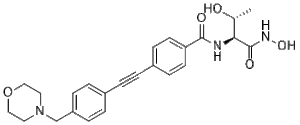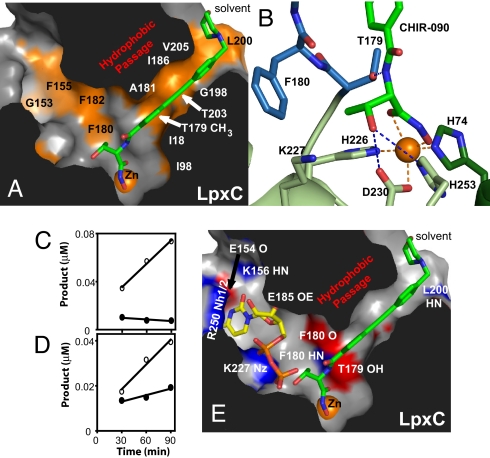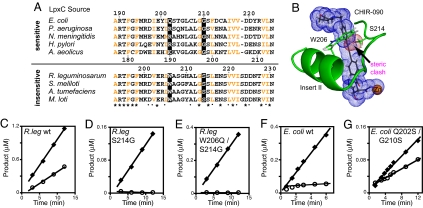This product is for research use only, not for human use. We do not sell to patients.

| Size | Price | Stock |
|---|---|---|
| 250mg | $1280 | Check With Us |
| 500mg | $1650 | Check With Us |
| 1g | $2475 | Check With Us |
Cat #: V2966 CAS #: 728865-23-4 Purity ≥ 98%
Description: CHIR-090 (CHIR090), a novel N-aroyl-l-threonine hydroxamic acid and antibiotic, is a highly potent, slow, and tight-binding inhibitor of the LpxC deacetylase from the hyperthermophile Aquifex aeolicus. LpxC is a deacetylase involved in the biosynthesis of LPS lipid A. CHIR-090 has excellent antibiotic activity against Pseudomonas aeruginosa and Escherichia coli, as judged by disk diffusion assays. CHIR-090 is also a two-step slow, tight-binding inhibitor of E. coli LpxC with Ki = 4.0 nM, Ki* = 0.5 nM, k5 = 1.9 min-1, and k6 = 0.18 min-1. CHIR-090 at low nanomolar levels inhibits LpxC orthologues from diverse Gram-negative pathogens, including P. aeruginosa, Neisseria meningitidis, and Helicobacter pylori. In contrast, CHIR-090 is a relatively weak competitive and conventional inhibitor (lacking slow, tight-binding kinetics) of LpxC from Rhizobium leguminosarum (Ki = 340 nM), a Gram-negative plant endosymbiont that is resistant to this compound.
Publications Citing InvivoChem Products
Product Promise

- Physicochemical and Storage Information
- Protocol
- Related Biological Data
- Stock Solution Preparation
- Quality Control Documentation
| Molecular Weight (MW) | 437.49 |
|---|---|
| Molecular Formula | C24H27N3O5 |
| CAS No. | 728865-23-4 |
| Storage | -20℃ for 3 years in powder formr |
| -80℃ for 2 years in solvent | |
| Solubility In Vitro | DMSO: ≥ 30 mg/mLr |
| Water: <1 mg/mLr | |
| Ethanol: <1 mg/mL | |
| Solubility In Vivo | O=C(N[C@@H]([C@H](O)C)C(NO)=O)C1=CC=C(C#CC2=CC=C(CN3CCOCC3)C=C2)C=C1 |
| SMILES Code | O=C(N[C@@H]([C@H](O)C)C(NO)=O)C1=CC=C(C#CC2=CC=C(CN3CCOCC3)C=C2)C=C1 |
| Synonyms | CHIR090; CHIR 090; CHIR-090 |
| Protocol | In Vitro | In vitro activity: CHIR-090, a novel N-aroyl-l-threonine hydroxamic acid, is a highly potent, slow, tight-binding inhibitor of the LpxC deacetylase from the hyperthermophile Aquifex aeolicus, and it has excellent antibiotic activity against Pseudomonas aeruginosa and Escherichia coli, as judged by disk diffusion assays. CHIR-090 is also a two-step slow, tight-binding inhibitor of E. coli LpxC with Ki = 4.0 nM, Ki* = 0.5 nM, k5 = 1.9 min-1, and k6 = 0.18 min-1. CHIR-090 at low nanomolar levels inhibits LpxC orthologues from diverse Gram-negative pathogens, including P. aeruginosa, Neisseria meningitidis, and Helicobacter pylori. In contrast, CHIR-090 is a relatively weak competitive and conventional inhibitor (lacking slow, tight-binding kinetics) of LpxC from Rhizobium leguminosarum (Ki = 340 nM), a Gram-negative plant endosymbiont that is resistant to this compound. Kinase Assay: Disk diffusion is conducted, except that 10 μg of each antibiotic compound is used per filter. Growth in liquid medium in the presence of CHIR-090 is evaluated as follows: cells from overnight cultures are inoculated into 50 mL portions of LB broth at an A600 of 0.02 and grown with shaking at 30°C. When the A600 reaches 0.15, parallel cultures are treated with either 6 μL of 500 μg/mL CHIR-090 in DMSO or 6 μL of DMSO. To assess cumulative growth, cultures are maintained in log phase growth by 10-fold dilution into pre-warmed medium, containing the same concentrations of DMSO or DMSO/CHIR-090, whenever the A600 reaches 0.4. The minimal inhibitory concentration is defined as the lowest antibiotic concentration at which no measurable bacterial growth is observed in LB medium containing 1% DMSO (v/v), when inoculated at a starting density of A600=0.01. Cultures are incubated with shaking for 24 h at 30°C in the presence of CHIR-090. Experiments are performed in triplicate Cell Assay: CHIR-090 at low nM levels inhibits LpxC orthologues from diverse Gram-negative pathogens, including Pseudomonas aeruginosa, Neisseria meningitidis, and Helicobacter pylori. In contrast, CHIR-090 is a relatively weak competitive and conventional inhibitor (lacking slow, tight-binding kinetics) of LpxC from Rhizobium leguminosarum (Ki=340 nM), a Gram-negative plant endosymbiont that is resistant to this compound. An E. coli construct in which the chromosomal lpxC gene is replaced by R. leguminosarum lpxC is resistant to CHIR-090 up to 100 μg/mL, or 400 times above the minimal inhibitory concentration for wild-type E. coli. CHIR-090, a very potent, slow, tight-binding inhibitor of Aquifex aeolicus LpxC, the sequence of which is 31 % identical toE. coli LpxC. CHIR-090 has remarkable antibiotic activity against E. coli and P. aeruginosa, comparable to ciprofloxacin, as judged by disk diffusion assays |
|---|---|---|
| In Vivo | CHIR-090 is a potent antibiotic against E. coli and inhibits E. coli LpxC activity in vitro in the low nM range. E. coli W3110 colonies resistant to 1 μg/mL CHIR-090 are not observed without prior chemical mutagenesis. A strain of E. coli W3110 is able to grow on LB agar plates containing 1 to 10 μg/mL CHIR-090, which is 4 to 40 times above the MIC of 0.25 μg/mL under our conditions for wild-type E. coli W3110. | |
| Animal model | NA | |
| Dosages | 1 to 10 μg/mL |
| Solvent volume to be added | Mass (the weight of a compound) | |||
|---|---|---|---|---|
| Mother liquor concentration | 1mg | 5mg | 10mg | 20mg |
| 1mM | 2.2858 mL | 11.4288 mL | 22.8577 mL | 45.7153 mL |
| 5mM | 0.4572 mL | 2.2858 mL | 4.5715 mL | 9.1431 mL |
| 10mM | 0.2286 mL | 1.1429 mL | 2.2858 mL | 4.5715 mL |
| 20mM | 0.1143 mL | 0.5714 mL | 1.1429 mL | 2.2858 mL |
This equation is commonly abbreviated as: C1 V1 = C2 V2
- (1) Please be sure that the solution is clear before the addition of next solvent. Dissolution methods like vortex, ultrasound or warming and heat may be used to aid dissolving.
- (2) Be sure to add the solvent(s) in order.







































